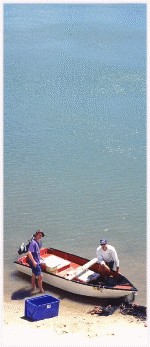Here I am, with a colleague (Dr Paul Cowley) sampling the Gqutywa estuary in the Eastern Cape, South Africa.
("Gqutywa" is a Xhosa word, said with a click that is nearly impossible to master if you don't already know how. And the word "Xhosa" is equally difficult to say unless you learned those glottal clicks as a child -- the ultimate ID check. If you can't say "Xhosa", you probably aren't. You can hear some of these amazing clicks in Miriam Makeba's "Click Song" if you can find a copy.)
Gqutywa is one of many small 'intermittently open' estuaries: estuaries with such small freshwater outflow that most of the time it all seeps through the sand. Occasionally, high seas or high rains cause flow above the sand (with temporary flushing of sand) and this allows fish to move between sea and estuary.
Many fish species in the region have a juvenile stage that (we believe) requires a period of estuary residence. They don't fit (not neatly, anyway) into the classic categories (anadromy, like salmon, or catadromy like eels) of diadromy, but we think (hypothesise) that this period of estuarine residence is in some cases obligatory, meaning that if a fish doesn't make it into the estuary at the right time in its life, it will not survive.
Some of the fish species that use the estuary are sport- or line-fish and are now at very low levels compared to levels of a few decades ago. The removal of water from rivers to irrigate crops in this arid region is an aquatic habitat conservation issue, because it affects the opening frequency of estuaries, and therefore has an impact on the population dynamics of fish that are estuary-dependent at one or more stages in their life history.
Water temperature is typically in the range 20-30C and, because of the low freshwater input and the occasional contribution of sea water during storms, salinities in these estuaries often reach much higher values than seawater. The sea is behind you, behind the high dune you are standing on; and the sea was very cold -- about 18 C.
